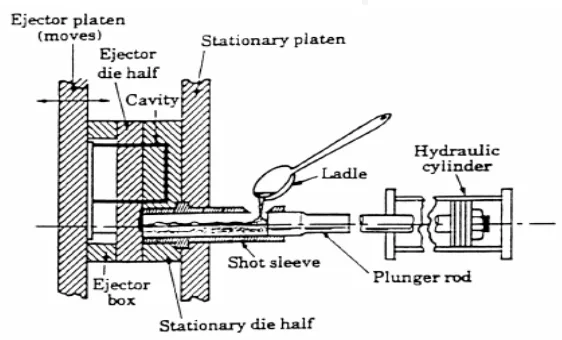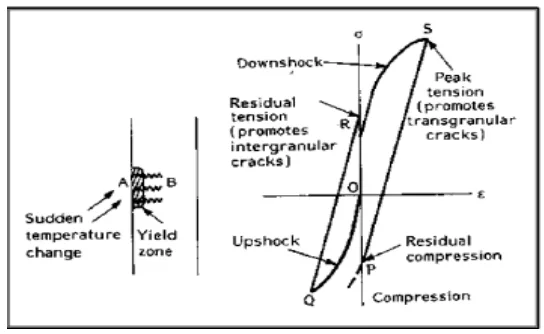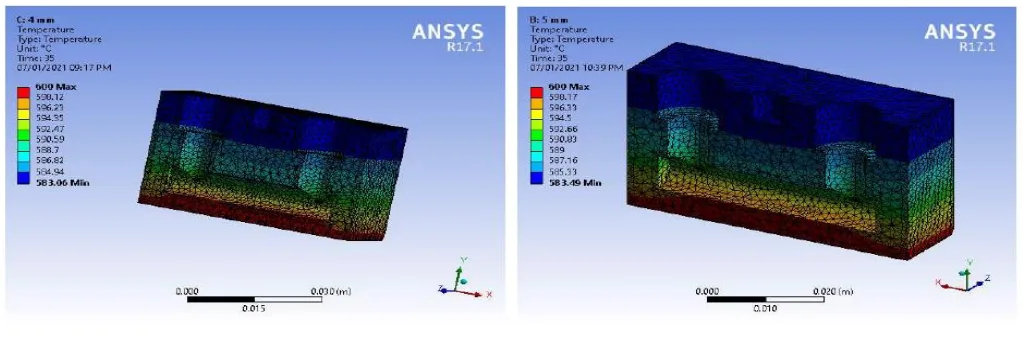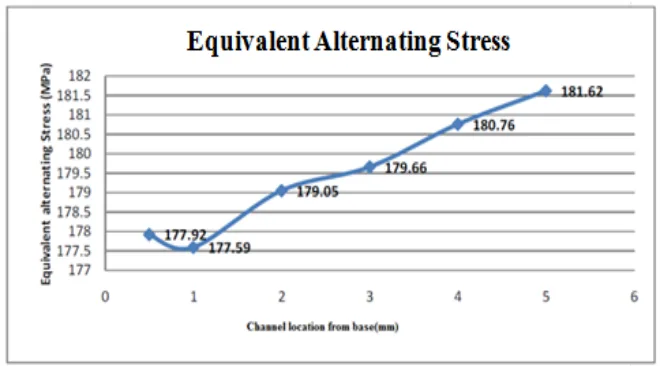냉각 채널 위치 최적화: 알루미늄 다이캐스팅 금형의 피로 수명을 극대화하는 방법
이 기술 요약은 Poshan Dewangan 외 저자들이 [International Journal of Scientific Research in Civil Engineering]에 발표한 학술 논문 "[Effect of Die Geometry on Fatigue Analysis of Aluminium Alloy (ADC12 Aluminium A383) using Pressure Die Casting Process]"(2021)을 기반으로 하며, CASTMAN의 기술 전문가들이 분석하고 요약했습니다.

키워드
- Primary Keyword: 다이캐스팅 금형 피로 수명
- Secondary Keywords: 알루미늄 다이캐스팅, 열 피로, 냉각 채널 설계, ADC12, A383, ANSYS 해석
Executive Summary
- The Challenge: 알루미늄 다이캐스팅 공정에서 금형의 열 피로 파손은 생산 비용 증가와 품질 저하의 주된 원인입니다.
- The Method: 연구팀은 ANSYS Workbench 17.1을 사용하여 냉각 채널의 위치가 ADC12(A383) 알루미늄 합금 다이캐스팅 금형의 온도 분포와 피로 수명에 미치는 영향을 시뮬레이션했습니다.
- The Key Breakthrough: 금형 베이스로부터 1mm 거리에 냉각 채널을 배치했을 때, 최소의 정상 응력(241.56 MPa)과 최장의 피로 수명(113,080 사이클)을 달성하는 최적의 조건임이 밝혀졌습니다.
- The Bottom Line: 금형의 냉각 채널 위치를 정밀하게 제어하는 것이 금형 수명을 연장하고 생산 경제성을 확보하는 데 결정적인 요소입니다.
The Challenge: Why This Research Matters for HPDC Professionals
고압 다이캐스팅(HPDC)은 얇고 복잡한 형상의 제품을 우수한 표면 마감과 정밀한 공차로 대량 생산할 수 있는 매우 비용 효율적인 공법입니다. 특히 자동차 산업의 엔진 블록, 실린더 헤드 커버 등 다양한 부품 생산에 널리 사용됩니다. 그러나 이 공정의 핵심인 금형은 주조 사이클마다 극심한 열적, 기계적 부하에 노출됩니다.
특히 알루미늄 합금과 같이 용융점이 높은 재료를 사용할 때, 금형의 수명은 열 피로 균열(Thermal fatigue cracking)에 의해 크게 제한됩니다. 주입 시 고온의 용탕과 접촉하고, 취출 후 냉각되는 과정이 반복되면서 금형 표면에 열 응력이 누적되어 미세 균열(heat checking)이 발생합니다. 이 균열은 제품의 표면 품질을 저하시키고, 결국 금형의 파손으로 이어져 막대한 교체 비용과 생산 시간 손실을 유발합니다. 따라서 금형의 수명을 연장하는 것은 다이캐스팅 산업의 경제성과 직결되는 매우 중요한 과제입니다.
The Approach: Unpacking the Methodology
본 연구는 금형의 열 피로 문제를 해결하기 위해 냉각 채널의 기하학적 위치가 미치는 영향을 분석했습니다. 연구팀은 다음과 같은 방법론을 사용했습니다.
- 소재: 자동차 및 소비재 부품에 널리 사용되는 고압 다이캐스팅용 알루미늄 합금 ADC12(A02240)를 대상으로 했습니다. 이 합금의 화학적 조성과 기계적 물성은 Table 2.1과 Table 2.2에 명시되어 있습니다.
- 모델링 및 시뮬레이션: 실제 다이캐스팅 금형의 3D CAD 모델(Fig. 3.1)을 생성하고, 유한요소해석(FEA) 패키지인 ANSYS Workbench 17.1을 사용하여 메시를 생성했습니다(Fig. 3.2). 이를 통해 과도 열 해석(Transient Thermal Analysis) 및 구조 해석을 수행했습니다.
- 핵심 변수: 연구의 핵심 변수는 금형 베이스(주조물과 직접 닿지 않는 바닥면)로부터 냉각 채널까지의 거리입니다. 이 거리를 0.5mm, 1mm, 2mm, 3mm, 4mm, 5mm로 변경하며 각 조건이 금형의 온도 분포, 응력, 피로 수명 등 다양한 파라미터에 미치는 영향을 분석했습니다.
The Breakthrough: Key Findings & Data
시뮬레이션 분석을 통해 냉각 채널 위치가 금형의 열 피로 수명에 결정적인 영향을 미친다는 사실이 구체적인 데이터로 입증되었습니다.
Finding 1: 냉각 채널 위치가 금형 표면 온도와 피로 수명을 결정한다
냉각 채널의 위치는 금형의 열 관리 효율과 직결됩니다. 분석 결과, 냉각 채널이 베이스에 가까울수록 강제 대류를 통한 열 전달률이 높아져 표면 온도를 효과적으로 제어할 수 있었습니다.
- Table 3.1에 따르면, 냉각 채널이 베이스로부터 0.5mm 거리에 있을 때 온도는 582.15°C였으며, 5mm로 멀어지자 583.49°C까지 상승했습니다.
- 이 미세한 온도 차이는 열 응력과 피로 수명에 큰 영향을 미쳤습니다. Figure 3.10과 Table 3.1에서 볼 수 있듯이, 피로 수명은 1mm 위치에서 113,080 사이클로 최대치를 기록했으며, 5mm 위치에서는 95,820 사이클까지 감소했습니다.
Finding 2: 최적의 냉각 채널 위치(1mm)에서 최소 응력 달성
피로 수명은 재료에 가해지는 응력의 크기와 직접적인 관련이 있습니다. 이 연구는 냉각 채널 위치가 응력 분포에 미치는 영향을 명확히 보여주었습니다.
- Table 3.1에 따르면, 정상 응력(Normal Stress)은 1mm 위치에서 241.56 MPa로 가장 낮았고, 4mm 위치에서는 245.76 MPa까지 증가했습니다.
- 피로 수명 예측에 사용되는 등가 교번 응력(Equivalent Alternating Stress) 역시 Figure 3.11에서처럼 1mm 위치에서 177.59 MPa로 최소값을 보였습니다. 이는 1mm 위치가 열팽창으로 인한 응력을 가장 효과적으로 완화하는 최적의 지점임을 의미합니다.
Practical Implications for R&D and Operations
본 연구 결과는 다이캐스팅 현장의 여러 담당자에게 실질적인 통찰을 제공합니다.
- For Process Engineers: 이 연구는 냉각 채널 위치를 금형 베이스에 가깝게(특히 1mm) 조정하는 것이 열 균열을 줄이고 금형 수명을 연장하는 데 기여할 수 있음을 시사합니다. 이는 금형 유지보수 주기를 늘리고 생산 효율성을 높이는 데 도움이 될 수 있습니다.
- For Quality Control Teams: 논문의 Table 3.1 데이터는 냉각 채널 위치가 등가 교번 응력에 미치는 영향을 보여주며, 이는 새로운 품질 검사 기준 수립에 참고 자료가 될 수 있습니다. 1mm 위치에서 177.59 MPa로 가장 낮은 응력을 보인 점은 금형의 건전성 평가 지표로 활용될 수 있습니다.
- For Design Engineers: 이 발견은 금형 설계 초기 단계에서 냉각 채널을 베이스로부터 1mm 거리에 배치하는 것이 열 피로 파손을 최소화하는 핵심 설계 요소임을 나타냅니다. 이는 금형의 내구성을 근본적으로 향상시키는 중요한 고려사항입니다.
Paper Details
Effect of Die Geometry on Fatigue Analysis of Aluminium Alloy (ADC12 Aluminium A383) using Pressure Die Casting Process
1. Overview:
- Title: Effect of Die Geometry on Fatigue Analysis of Aluminium Alloy (ADC12 Aluminium A383) using Pressure Die Casting Process
- Author: Poshan Dewangan, Ved Prakash Dewangan, Sushil Kumar Maurya, Lokesh Singh
- Year of publication: 2021
- Journal/academic society of publication: International Journal of Scientific Research in Civil Engineering (IJSRCE), Volume 5, Issue 2
- Keywords: Aluminium Alloys, Die-Casting, Thermal Fatigue, Temperature Distribution, Life
2. Abstract:
Dies for aluminium alloys die-casting fail because of a great number of different and simultaneously operating factors. Some of them may be controlled to some extent by the die-casting experts. In the process of the die-casting the primary source of loading is cyclic variation of the temperature; the influence of other loads is relatively insignificant. For economical production of aluminium and aluminium alloys die castings it is important that the dies have a long working life. The replacement of a die is expensive in both: money and production time. The die design, the material selection and the process thermal fatigue stress which is the consequence of the working conditions, the inhomogeneous and to low initial temperature of the die, contribute to the cracks formation. The main objective of this work to find out The thermal fatigue of die casting Aluminium Alloy (A02240) causes reduction in tool life and seriously affects the surface conditions such as microstructure, hardness, surface finish and residual stresses. The size and location of cooling channels relative to the surface of the die, which affect the thermal stresses and fatigue life of dies. This work focus on thermal fatigue analysis of Aluminium alloy pressure die casting process and analyses the effect of coolant channel location on temperature distribution and fatigue parameters such as life, damage, equivalent alternating stress and biaxiality using ANSYS Workbench 17.1 finite-element package.
3. Introduction:
Die casting is a very cost-efficient method of forming thin walled and complex near net-shaped products with geometric tolerances and good surface finish. Low melting point alloys based on aluminium, zinc, magnesium and copper are frequently used. Many different types of products are manufactured by die casting such as engine blocks, cylinder head covers, valves, Pipe coupling etc. and other components for the automotive industry and for heating etc. In die casting, large numbers of identical products are produced using one die, which is necessary, since the die is very expensive. Any kind of tool failure that causes rejection of casting and extra tool maintenance increases the production costs. The overall aim of this work to development of better tool materials for die casting. Die Casting tools are exposed to thermal mechanical and chemical conditions during each casting cycle. The service life of tools for aluminium die casting is most important thermal fatigue cracking, erosion, corrosion of the casting alloy to the tool. Thermal fatigue cracking in die casting of aluminium alloy, since the temperature of the melt is high.
4. Summary of the study:
Background of the research topic:
알루미늄 합금 다이캐스팅용 금형은 반복적인 열 사이클로 인해 열 피로를 겪으며, 이는 균열 형성으로 이어져 금형 수명을 단축시키고 생산 비용을 증가시킵니다. 금형 설계, 재료 선택, 공정 조건 등이 이러한 열 피로 응력에 영향을 미칩니다.
Status of previous research:
기존 연구들은 다이캐스팅 금형의 파손 메커니즘으로 열 피로, 침식, 부식 등을 지적해왔습니다. 특히 열 피로는 금형 수명에 가장 큰 영향을 미치는 요인으로, 열 구배로 인해 발생하는 응력이 주요 원인으로 알려져 있습니다.
Purpose of the study:
본 연구의 주요 목적은 다이캐스팅 알루미늄 합금(A02240)의 열 피로 현상을 규명하고, 금형 표면으로부터 냉각 채널의 크기와 위치가 열 응력 및 피로 수명에 미치는 영향을 분석하는 것입니다. 이를 통해 금형 수명을 연장하고 제품의 표면 품질을 개선하고자 합니다.
Core study:
이 연구는 ANSYS Workbench 17.1 유한요소 패키지를 사용하여 알루미늄 합금 압력 다이캐스팅 공정의 열 피로 분석에 중점을 둡니다. 특히 냉각 채널 위치가 온도 분포 및 피로 수명, 손상, 등가 교번 응력, 이축성(biaxiality)과 같은 피로 파라미터에 미치는 영향을 분석합니다.
5. Research Methodology
Research Design:
본 연구는 시뮬레이션 기반의 분석 연구로 설계되었습니다. 다이캐스팅 금형의 3D 기하학적 모델을 생성하고, 냉각 채널의 위치를 주요 변수로 설정하여 과도 열 해석 및 구조 해석을 연계하여 수행했습니다.
Data Collection and Analysis Methods:
데이터는 ANSYS Workbench 17.1을 사용한 유한요소 시뮬레이션을 통해 수집되었습니다. 냉각 채널 위치(0.5mm ~ 5mm)에 따른 온도 분포, 정상 응력, 피로 수명, 피로 손상, 등가 교번 응력 등의 데이터를 계산하고 비교 분석했습니다.
Research Topics and Scope:
연구 범위는 ADC12(A02240) 알루미늄 합금을 사용하는 압력 다이캐스팅 공정에 사용되는 금형으로 한정됩니다. 연구 주제는 금형의 기하학적 구조, 특히 냉각 채널의 위치가 열 피로 특성에 미치는 영향에 초점을 맞춥니다.
6. Key Results:
Key Results:
- 냉각 채널이 베이스로부터 멀어질수록 금형 표면 온도는 증가하는 경향을 보였습니다 (0.5mm에서 582.15°C, 5mm에서 583.49°C).
- 피로 수명은 냉각 채널이 베이스로부터 1mm 거리에 있을 때 113,080 사이클로 가장 길었으며, 이때 정상 응력(241.56 MPa)과 등가 교번 응력(177.59 MPa)이 가장 낮았습니다.
- 냉각 채널 위치가 0.5mm에서 1mm로 이동할 때 피로 손상은 8965.4에서 8843.1로 감소하며 가장 낮은 값을 보였습니다.
- 결론적으로, 베이스로부터 1mm 거리에 냉각 채널을 배치하는 것이 열 피로 저항성 측면에서 가장 우수한 설계인 것으로 나타났습니다.
Figure Name List:
- Fig.1.1: Cold-chamber die casting
- Fig.1.2: Hysteresis loop at the surface of a material subjected to cyclic heating cooling
- Fig.3.1: Geometrical 3D CAD model
- Fig.3.2: Messing of Die Geometry
- Fig.3.3 (a) Temperature Distribution for 0.5 mm base location (b) Temperature Distribution for 1 mm base location
- Fig.3.4 (a) Temperature Distribution for 2 mm base location (b) Temperature Distribution for 3 mm base location
- Fig.3.5 (a) Temperature Distribution for 4 mm base location (b) Temperature Distribution for 5 mm base location
- Fig.3.6 (a) Fatigue Life for 0.5 mm base location (b) Fatigue Life for 1 mm base location
- Fig.3.7 (a) Fatigue Life for 2 mm base location (b) Fatigue Life for 3 mm base location
- Fig.3.8 (a) Fatigue Life for 4 mm base location (b) Fatigue Life for 5 mm base location
- Fig. 3.9: Temperature distribution for aluminium alloy
- Fig. 3.10: Fatigue life for aluminium alloy
- Fig. 3.11: Equivalent alternating stress for aluminium alloy



7. Conclusion:
고압 다이캐스팅의 수명은 베이스 근처에 효과적인 냉각 채널을 사용하고 작동 온도에서 기계적 특성의 열적 안정성을 높임으로써 증가될 수 있습니다. Workbench 17.1 패키지를 사용하여 온도 분포, 정상 응력 및 피로 수명을 주로 포함하여 특성화하기 위해 열 피로 분석을 수행했습니다. 결과는 베이스에서 0.5mm의 냉각 채널 위치가 최대 정상 응력 245.39 MPa, 최소 피로 수명 9582를 유발함을 나타냈습니다. 그러나 베이스에서 1mm의 냉각 채널 위치는 582.18°C의 온도를 경험하며, 이는 최소 정상 응력 241.56 MPa, 피로 수명 11308 사이클에 해당합니다. 이것이 냉각 채널 위치 중에서 최고로 간주됩니다.
8. References:
- [1]. JCollot et alReview of New Process Technologies in the Aluminum Die-Casting IndustryMaterials and Manufacturing Processes, 200116(5): p595-617.
- [2]. QHan, and SViswanathan, Analysis of the mechanism of die soldering in aluminium die castingMetallurgical and Materials ransactions, 200334(1): p139-146.
- [3]. ASrivastava, VJoshi and R Shivpuri; 2004; Computer modelling and prediction of thermal fatigue cracking in diecasting toolingIntJWear 256: 38-43.
- [4]. DSchwam, JFWallace and SBirceanu; 2004; Effect of design factors on thermal fatigue cracking of die casting diesDE-FC07-00ID138486,US Department of Energy, Washington, DC.
- [5]. DNovovic, RCDewes and DKAspinwall;2004; The effect of machined topography and integrity on fatigue lifeIntJMach Tools Manuf44 :125-134.
- [6]. MOkayasu; 2009; Comparison of mechanical properties of die cast aluminium alloys: cold vshot chamber die casting and high vslow speed filling die castingIntJCast MetRes22: 324-381.
- [7]. SAqida etal., Thermal fatigue properties of laser treated steelsInternational Journal of Material Forming, 20103(1): p797-800.
- [8]. J.J.Moverare,; DGustafsson Hold-time effect on the thermo-mechanical fatigue crack growth behaviour of inconel 718MaterSciEngA 2011, 528, 8660-8670.
- [9]. SChang, K.Huang, and YWang, Effects of thermal erosion and wear resistance on AISI H13 tool steel by various surface treatments Materials Transactions, 201253(4): p745-751.
- [10]. DKlob car.; LKosec; J.Tušek; Thermo fatigue cracking of die casting diesEngFailAnal2012, 20, 43-53.
- [11]. IKoutiri, et al., High cycle fatigue damage mechanisms in cast aluminium subject to complex loadsInternational Journal of Fatigue, 201347: p44-57.
- [12]. DMatiskova,.; SGaspar,.; LMura,Thermal factors of die casting and their impact on the service life of moulds and the quality of castingsActa Polytech Hung2013, 10, 65–78.
- [13]. DMatiskova,.; SGaspar,.; LMura,Thermal factors of die casting and their impact on the service life of moulds and the quality of castingsActa PolytechHung2013, 10, 65–78.
- [14]. Fazliana Fauzun, SNAqida, SNaher and DBrabazon;2014; effects of thermal fatigue on laser modified H13 Die Steel; Journal of mechanical engineering and sciences(JMES);ISSN:2289-4659; volume 6, pp975-980.
- [15]. Xu, W.; Li, W.; Wang, YExperimental and theoretical analysis of wear mechanism in hot-forging die and optimal design of die geometryWear 2014, 318, 78-88.
- [16]. Qian wan, Haidong Zhao and Chun Zou; 2014; effect of micro porosities on fatigue behavior in Aluminium die casting by 3D x-ray tomography inspection; doi.org/10.2355/isijinternatinal.
- [17]. OAmmar,; NHaddar,; LRemy, Numerical computation of crack growth of low cycle fatigue in the 3041 austenitic stainless steelEngFractMech2014, 120, 67-81.
- [18]. IVicario, JKIdoiaga, EArratibel and PCaballero;2015; Development of HPDC advanced dies by casting with reinforced tool steels; International Journal of manufacturing Engineering;doi.org/10.1155/2015/287986.
- [19]. CChen; YWang; Energy-based approach to thermal fatigue life of tool steels for die casting diesIntJFatigue 2016, 92, 166–178.
- [20]. Xu Li, Bao-sheng Liu, Li-feng Hou and Ying-hui Wei;2017; Failure investigation of an AlSi9Cu3 Alloy Die-Cast Cavity Insert; Journal of failure analysis and prevention; issue6.
- [21]. Ibrahim Ozbay, Tamer Aydiner, Gurkan Yilmazoglu and Hafize Celik;2019; Aluminium high pressure Die casting application on rear frame rails; European mechanical science; e-ISSN: 2587-1110.
- [22]. Federico Simone Gobber, Andrea Giuseppe Pisa and Mario Rosso;2019; design of a Test Rig for the characterization of thermal fatigue and soldering resistance of the surfaces of tool steels for high pressure die casting dies; Steel research International: doi.org/10.1002/srin.201900480.
Expert Q&A: Your Top Questions Answered
Q1: 왜 이 연구에서는 ADC12(A02240) 알루미늄 합금을 사용했습니까?
A1: 논문에 따르면, 알루미늄, 아연, 마그네슘, 구리 기반의 저융점 합금은 다이캐스팅에 자주 사용됩니다. ADC12(A02240)는 자동차 엔진 블록, 실린더 헤드 커버 등 다양한 부품에 널리 사용되는 대표적인 알루미늄 합금입니다. 따라서 이 소재를 대상으로 한 연구는 실제 산업 현장에 직접적으로 적용될 수 있는 높은 실용적 가치를 가집니다.
Q2: Table 3.1에서 냉각 채널이 1mm일 때 피로 수명이 가장 긴 이유는 무엇입니까?
A2: 논문의 데이터에 따르면, 1mm 위치는 열 관리와 응력 완화 사이의 최적의 균형점입니다. 이 위치에서 금형은 효과적인 냉각을 통해 열팽창을 최소화하여 가장 낮은 정상 응력(241.56 MPa)과 등가 교번 응력(177.59 MPa)을 보였습니다. 응력 수준이 낮을수록 재료가 견딜 수 있는 반복 사이클 수가 증가하므로, 결과적으로 가장 긴 피로 수명(113,080 사이클)을 달성한 것입니다.
Q3: 냉각 채널이 베이스에서 멀어질수록 온도가 미세하게 상승하는 이유는 무엇입니까?
A3: 논문의 4.1절에 따르면, 냉각 채널이 바닥 표면에 가까울수록 강제 대류(forced convection)를 통한 열 전달률이 높아져 열팽창이 줄어듭니다. 반대로 냉각 채널이 베이스에서 멀어지면 열 전달 효율이 감소하여 금형 표면의 온도가 미세하게 상승하게 됩니다. 이러한 온도 상승은 열 응력을 증가시켜 피로 수명을 단축시키는 요인으로 작용합니다.
Q4: 이 연구에서 사용된 시뮬레이션 소프트웨어는 무엇이며, 그 이유는 무엇입니까?
A4: 본 연구에서는 ANSYS Workbench 17.1 유한요소 패키지를 사용했습니다. 논문의 초록과 3.1절에서 언급되었듯이, 이 소프트웨어는 다이캐스팅 공정의 열 피로 분석을 수행하는 데 사용되었습니다. 특히 온도 분포, 수명, 손상, 등가 교번 응력과 같은 복잡한 피로 파라미터를 계산하고 분석하는 데 강력한 기능을 제공하기 때문에 이 연구에 적합했습니다.
Q5: 결론 부분에서 언급된 피로 수명(11,308 사이클)과 Table 3.1의 값(113,080 사이클)이 다른데, 어느 쪽을 신뢰해야 합니까?
A5: 논문 내 데이터 불일치가 확인됩니다. 결론 섹션에서는 1mm 위치의 피로 수명을 11,308 사이클로 언급했지만, 결과 요약표인 Table 3.1과 그래프인 Figure 3.10에서는 일관되게 113,080 사이클로 표시하고 있습니다. 표와 그래프 데이터가 서로 일치하고, 다른 위치 값들과의 상대적 크기를 고려할 때, 결론 부분의 값은 오타일 가능성이 매우 높습니다. 따라서 113,080 사이클이 연구 저자가 의도한 정확한 결과값으로 판단됩니다.
Conclusion: Paving the Way for Higher Quality and Productivity
이 연구는 알루미늄 다이캐스팅 공정에서 금형의 냉각 채널 위치가 다이캐스팅 금형 피로 수명에 얼마나 결정적인 영향을 미치는지를 명확하게 보여줍니다. 베이스로부터 단 1mm 거리에 냉각 채널을 배치하는 간단한 설계 최적화를 통해 응력을 최소화하고 금형 수명을 최대화할 수 있다는 점은 매우 중요한 시사점입니다. 이는 단순한 수명 연장을 넘어, 생산성 향상과 품질 안정화, 그리고 원가 절감으로 이어지는 핵심 요소입니다.
"CASTMAN은 최신 산업 연구 결과를 적용하여 고객이 더 높은 생산성과 품질을 달성할 수 있도록 최선을 다하고 있습니다. 이 논문에서 논의된 과제가 귀사의 운영 목표와 일치한다면, CASTMAN의 엔지니어링 팀에 연락하여 이러한 원칙을 귀사의 부품에 어떻게 구현할 수 있는지 논의해 보십시오."
Copyright Information
- 이 콘텐츠는 "[Poshan Dewangan, et al.]"의 논문 "[Effect of Die Geometry on Fatigue Analysis of Aluminium Alloy (ADC12 Aluminium A383) using Pressure Die Casting Process]"를 기반으로 한 요약 및 분석 자료입니다.
- Source: [https://ijsrce.com/IJSRCE21528]
이 자료는 정보 제공 목적으로만 사용됩니다. 무단 상업적 사용을 금지합니다. Copyright © 2025 CASTMAN. All rights reserved.